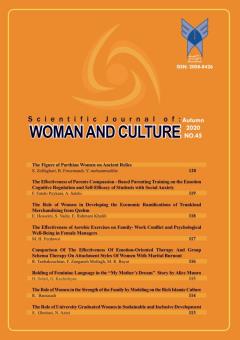Bolding of Feminine Language in the "My Mother's Dream" Story by Alice Munro
Subject Areas : Sociology
Hossein Solati
1
![]() ,
Garineh Keshishyan
2
,
Garineh Keshishyan
2
1 - Payame Noor University of Tehran, Department of Ploitical Sciences, Tehran, Iran.
2 - Islamic Azad University South Tehran Branch, Department of Ploitical Sciences, Tehran, Iran.
Keywords: Alice Munro, feminine language, "My Mother's Dream" story,
Abstract :
The purpose of this study was to study and highlight the elements of feminine language in Alice Munroe's book. The research universe consisted of "My Mother's Dream" Stories. The sample subsummed the feminine writing and language semiotics of Alice Munroe's works.The research desgine was qualtive.The data collecting was conducted through the selction of gendered terminologies of the Persian version of the mentioned book. Few stories of Munroe's works with frequent feminine writing and language semiotics were reviewed via content analysis method to bold the feminine language experineces based on the conventional elements of the content analysis. To maintain the balance between language as a social product and translation as a media of social interaction, more attention was taken to the character and atmosphere of the story than words.The study concluded that promotion and bolding the elements of feminine language would provide a way to prevent the continuation of gender inequality. As a result, the findings of this study showed that in the gendered literature, the subject of one gender experience was deliberately given less attention so that women's experiences in societies with hidden masculine structures could be reflected. Thus, feminine writing sometimes went to the extremes to portray the masculine ineffectuality.
- بلوری، مزدک. (1396). نقش سیاستهای حوزهی زنان در انتخاب آثار ادبی فمینیستی برای ترجمه به زبان فارسی. فصلنامه مطالعات زبان و ترجمه. پاییز، 3: 29-47.
- بهمنیمطلق، یدالله، باقری، نرگس. (1391). مقایسه زبان زنان در آثار سیمین دانشور و جلال آلاحمد. فصلنامه زن و فرهنگ. بهار، 3 (11): 43-9.
- حقیقت، سیدصادق. (1398)،. روششناسی علوم سیاسی. چاپ پنجم. قم: دانشگاه مفید.
- حلاجزاده بناب، حسین.، خلیفهلو، سیدفرید.، آقاگلزاده، فردوس. (1397). شیوهی بازنمایی کنشگران اجتماعی در گفتمان زنان خواستار طلاق بر اساس الگوی 2008 ونلیوون، رویکرد زبانشناسی حقوقی، دوماهنامه جستارهای زبانی، مهر و آبان، 9(4، پیاپی 46): 113-13.
- رحیمسلمانی، آرزو. (1391). مروری بر تحلیل محتوا. آینه پژوهش. آذر، 23 (5 و 6): 30-40.
-رضوانیان، قدیسه.، ملک، سروناز. (1392). بررسی تأثیر جنسیت بر زبانزنان شاعر معاصر. مجله شعرپژوهی (بوستان ادب). دانشگاه شیراز. پاییز، 5 (3، پیاپی 17): 45-70.
- شریفی، مسعود.، زند، فاطمه. (1392). تأثیر زبانزنانه و نگرشهای فرهنگی جنسیتی بر ترجمه، فصلنامه مطالعات زبان و ترجمه، دانشکده ادبیات و علوم انسانی، پاییز، 3: 143-165.
- طاهری، قدرتاله. (1388). زبان و نوشتار زنانه؛ واقعیت یا توهم؟. فصلنامه زبان و ادب پارسی. زمستان، 42: 87-107.
- فروتن، یعقوب. (1390). زنان و زبان: بازنمایی هویت جنسیتی در کتابهای زبانهای فارسی، عربی و انگلیسی مدارس ایران. فصلنامه مطالعات زنان، پاییز، 9 (2): 161-181.
- گرین، کیت.، لبیهان، جیل. (1996). درسنامهی نظریه و نقد ادبی. ترجمه لیلا بهرانی، مازیار حسینزاده، اکرم حسینی، فاطمه حسینی، پروانه حکیمجوادی، فرناز فتاحی و بردیا لشگری (1383). تهران: روزنگار.
- معینیان، نرمینه. (1395). بررسی جامعهشناختی تفاوت زبان بین زنان و مردان. فصلنامه مطالعات جامعهشناختی. زمستان، 9 (33): 83-93.
- مونرو، آلیس. (2001). رویای مادرم. ترجمه ترانه علیدوستی. (1391). چاپ چهارم. تهران: نشر مرکز.
- نوذری، حسینعلی. (1394). پست مدرنیته و پست مدرنیسم. چاپ چهارم. تهران: انتشارات نقش جهان.
- Fairus, R., & Fauzi, A. (2017). The Role of Gender in the Process Translation. Journal of Applied Linguistics and Language Research, 4(4), 273-282.
- Von Flotow, L. (2016). Translation and Gender: Translating in the'era of Feminism'. Routledge, First Published 1997.
- Weatherall, Ann. (2005). Gender, language and discurse, USA and Canada by Routledge.
_||_

